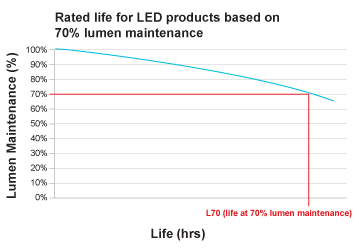Life and Lumen Maintenance
Traditionally the rated lamp life of light sources is defined as an average rating, in hours, for the time it takes 50% of a large group of the lamps to fail (called C50* as defined by IEC 62717). However, this rating is purely based on survival and does not take into account lumen depreciation. An additional way of measuring life is therefore required for LEDs, which can have extremely long lives but dim gradually over the life of the lamp.

| 6,000-Hour Lumen Maintenance Thresholds Table from Energy Star | |
| Minimum lumen maintenance at end of 6,000 hours (% of initial lumens; -3% tolerance) |
Maximum L70 Life Claim (hours) |
|---|---|
| 86.7% | 15,000 |
| 89.9% | 20,000 |
| 91.8% | 25,000 |
| 93.1% | 30,000 |
| 94.1% | 35,000 |
| 94.8% | 40,000 |
| 95.4% | 45,000 |
| 95.8% | 50,000 |
To measure the lumen depreciation, an LED is tested under normal operating conditions and the lumen output of the lamp is measured at 6,000 hours. This measurement is then compared to the initial output of the lamp and the depreciation of lumen output calculated- see Energy Star table. This is then extrapolated on a lumen maintenance curve- see graph.
The resultant curve shows the amount of remaining luminous flux output- expressed as a percentage of the initial output- at any selected elapsed operating time. This data then makes it possible for manufacturers to provide a relative lumen output calculation over a lamps’ life and, importantly, to be able to indicate the point at which an LED will be operating at an output level that is not considered viable in terms of light quality. This point is called the useful life (Lxx for LED modules) and shows the elapsed operating time at which a specified percentage of lumen maintenance is reached - this is expressed in hours. To illustrate this, if an LED module has a useful life of L70(B10**) at 40,000 hours, (B10 means only 10% of working LEDs have failed to reach the 70% maintenance), then after 40,000 hours operation the lumen output will still remain at 70% of its initial output level for at least 90% of the working LED.
MEGAMAN® quotes this L70 number for all LED products which is the expected time when used in normal and open conditions for the unit to reach 70% lumen maintenance and the end of useful life. MEGAMAN® also tests all LEDs in the most onerous conditions, for example to simulate use in enclosed fixtures, and calculates a combined useful life including abrupt failures, both this and the L70 life are quoted.
MEGAMAN® has an ongoing program for long term life test of professional LED’s. Test measurements of lumen output are taken regularly to verify the projections of lumen maintenance and life. For this reason life claims may change and the website should be referenced for the latest information. IEC 62612 & 62717 published during 2014 will go through an implementation phase and some of the definitions and declarations will change as all countries come into line. (www.megaman.cc)
* C for catastrophic failure, no light output
** B for parametric failure, output below certain level

 top
top